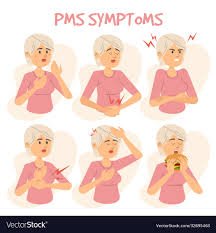A large number of women are familiar with the extreme emotions and sometimes, physical discomfort that comes with premenstrual Syndrome. It does not help sexually active women who are not willing to get pregnant yet, especially due to the fact that its signs and symptoms bear resemblance to the signs of pregnancy.
However, premenstrual syndrome can be a blessing – as it assures you that your body is acting as it should since you’re still in your reproductive years – and not so much of a blessing if you’re willing to get pregnant but its kind of difficult for you.
In this article, the causes of premenstrual syndrome, its symptoms, and available treatments will be discussed. By the time you are done with this publication, you will be equipped with how to deal with premenstrual syndrome.
What is Premenstrual Syndrome?
As the name implies, it is the syndrome – recognizable and predictable pattern of signs and symptoms – that is noticeable in females (that are in their years of reproduction) when it is a few weeks to that time of the month for their menstrual flow.
Premenstrual syndrome is characterized by a combination of emotional, psychological, and physical signs that render the females, depending on the degree of severity, uncomfortable and most times, irritable.
There are speculations surrounding the reason this condition plagues 3 out of 4 women who are still menstruating. Some of the logical ones include a change in hormonal levels and interference with brain chemicals.
What Causes premenstrual Syndrome?
The cause of premenstrual syndrome is not clearly known. However, there are some factors that are known to be contributors to the conditions and may affect its severity. They include:
Depression
Some women that experience severe symptoms of premenstrual syndrome have underlying conditions like undiagnosed depression. Though it is not solely responsible the other symptoms, it exacerbates the emotional and psychological symptoms of premenstrual syndrome.
Brain Chemical Changes
A drop in the level of serotonin, a chemical in the brain that influences mood changes, can cause premenstrual syndrome. The level of serotonin in the brain fluctuates due to the level of estrogen and progesterone in the body which inhibits its production. Serotonin levels is responsible for mood changes, appetite, insomnia, and fatigue.
Hormonal Changes
Hormones such as estrogen and progesterone are important in maintaining the regularity of the menstrual cycle. Therefore, at about two weeks before menstruation, that is, after ovulation, the level of these hormones spike and drop at different times. This confuses the body and alters the body chemistry for a while.
What are the Symptoms of Premenstrual Syndrome?
Premenstrual syndrome manifests emotionally, psychologically, and physically, so do its symptoms. The symptoms of premenstrual syndrome vary in intensity from person to person and from cycle to cycle. The symptoms that are more pronounced in one cycle may not manifest in the next.
Physical Symptoms
- Headache
- Weight gain due to fluid retention
- Fatigue
- Abdominal cramps
- Constipation
- Acne flare-ups
- Breast tenderness
- Muscle pain
Emotional Symptoms
- Mood swings and irritability
- Anxiety
- Exaggerated emotional outbursts
- Appetite changes
- Change in libido
- Insomnia
- Depression
- Poor concentration
- Social withdrawal
Treatment for Premenstrual Syndrome
There are different options when it comes to the treatment of premenstrual syndrome. The treatment options adopted depends on the nature of symptoms manifested.
The options of treatment for managing the symptoms of premenstrual syndrome are:
Medication
Medication is effective against physical symptoms like headache, abdominal cramps. Over-the-counter pain relief medications are effective in managing these physical symptoms.
Medications such as diuretics help in reducing bloating and breast tenderness. There are other medications that aid in bowel movement and help treat constipation and diarrhea.
In extreme cases, gonadotropin-releasing medications such as birth control pills and patches help to inhibit the spike of estrogen and progesterone and consequently stops many of the symptoms that come with premenstrual syndrome.
Dietary changes
Symptoms such as bloating, acne flare-up, diarrhea, and constipation are effectively treated by eating the right foods.
To treat constipation and diarrhea, eat foods that are high in fiber and healthy oil. This helps easy digestion of food and bowel movement. It also helps to put weight gain in check.
For acne flare-up, eat fruits and vegetables as they contain high amounts of vitamins such as vitamin C and E, and minerals such as potassium, calcium, and magnesium.
Water is part of your food, ensure to keep yourself hydrated. It helps to treat headache and weight gain due to water retention.
Exercises
Simple exercises such as walking and jogging have been known to be helpful in treating premenstrual symptoms. Other exercises like weight lifting, resistance training and sprinting, also has the same beneficial effects.
Exercises are known to help in improving emotional and psychological conditions during premenstrual period. It helps to improve the mood by raising the level of serotonin in the body, thereby treating depression, anxiety, and social withdrawal effectively.
Exercises also help to improve the quality of sleep.
Alternative treatment method
Some women prefer the alternative route of treatment. They include acupuncture, herbal medicine, and stress management and relaxation techniques.
These stress management and relaxation techniques include stretching, walk, tai chi, yoga, a bath, speaking with a close friend, consulting a mental counselor.
Conclusion
Premenstrual syndrome is a common condition among women in their active reproductive years. It happens about two weeks before menstruation and comes with symptoms that can be emotional, psychological, and physical.
To treat these symptoms, options such as medications, exercises, dietary changes, and alternative treatment methods are available. The suitable treatment method depends on the symptom to be treated.
